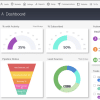Source: Local News 8 —
Fewer people are taking out mortgages as interest rates increase
Americans are taking out fewer mortgage loans as interest rates increase, a reflection of buyer uncertainty amid rising inflation, higher interest rates, and concerns about economic slowdowns. And even as mortgage rates hover near highs not seen in 20 years, mortgage amounts have yet to fall back to pre-pandemic levels.
Experian examined mortgage rate data and the number of new mortgages in the U.S. to see how rising interest rates affect potential homebuyers. This analysis looked at the number of mortgages made for all types of first-lien mortgages through the third quarter (Q3) of 2022.
Mortgage rates measure the interest that a lender charges, expressed as a percentage of the loan amount. Fixed-term conventional mortgage rates are determined using many factors, including the overall health of the economy and the federal funds rate. The Federal Reserve usually raises interest rates in times of strong economic growth and as a means of mitigating inflation.
The number of mortgages issued in the U.S. fell 62.3% in Q3 2022 compared to the same period the year before, according to Experian. Mortgage counts fell the most in Western states, including Oregon, California, and Idaho. And in addition to the number of mortgages issued dropping, the median loan amount per borrower in the U.S. fell to $295,000 in October 2022—lower than it’s been since January 2021.
To understand the changing mortgage market, it’s important to also understand the unprecedented ups and downs of the housing market over the past few years. At its onset, the COVID-19 pandemic slowed homebuilding drastically. And even though the construction industry kicked into high gear as pandemic restrictions eased across the country, supply remained constricted. Issues in the complex network of building materials suppliers worldwide, as well as natural disasters and a shortage of truck drivers and transportation, limited how quickly builders could move ahead.
And even as construction activity recovered, demand for homes far outstripped the available supply. Driven by a desire for more space—and low interest rates meant to spur economic recovery from the COVID-19 recession—eager would-be home buyers jumped into the market. Joining them were flippers, institutional investors, and corporations that were often locked into fierce competition for the housing stock available.















